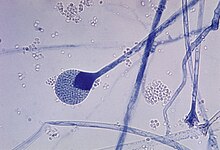Mucorales
| Mucorales | |
|---|---|
 |
|
| A sporangium of a Mucoralean fungus | |
| Scientific classification | |
| Kingdom: | Fungi |
| Subdivision: | Mucoromycotina |
| Order: | Mucorales |
| Families | |
The Mucorales is the largest and best studied order of Zygomycete fungi. Members of this order are sometimes called pin molds.
The order includes 12-13 families, 56 genera and approximately 300 species. Mucoralean classification has traditionally been based on morphological, developmental, and ecological characters. Recently, molecular data have revealed that some aspects of traditional classification are quite artificial. For example, the Mucoraceae is believed to be polyphyletic, as are the Thamnidiaceae, and Radiomycetaceae. Some of the genera, (including Mucor, Absidia and Backusella) appear to be polyphyletic. Today, the traditional system is still largely in use, as further studies are needed to reconcile morphological and molecular concepts of families and genera.
Mucoralean fungi are typically fast-growing, and their wide hyphae lack septa (multiperforate septa are present only in sporangiophores and gametangia). The hyphae grow mostly within the substrate. Sporangiophores are upright (simple or ramified) hyphae that support sac-like sporangia filled with asexual sporangiospores.
Many are known by the damage they do to stored food. Others can cause a mycosis (infection), generally in patients already infected with other diseases. various types of spores in Mucorales 1 Merosporangia 2 Oidia 3 Sporangiola
...
Wikipedia
